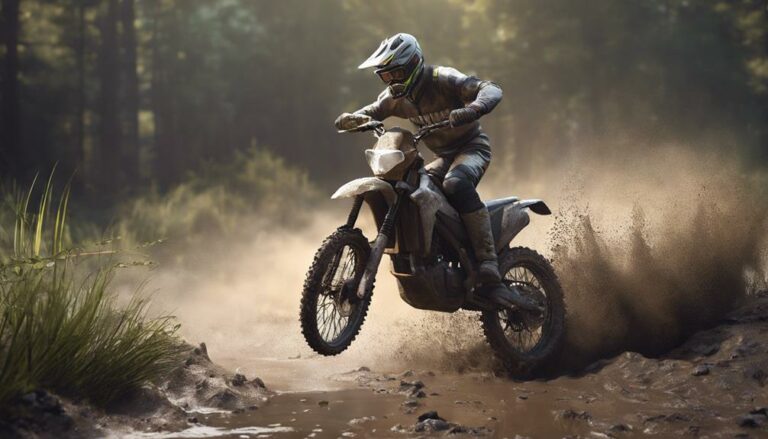Imagine traversing through a muddy trail, your tires slipping and sliding like a dance on ice. Just like a skilled dancer, mastering the art of off-road riding in muddy environments requires finesse and caution.
Understanding the key safety considerations can make all the difference between a thrilling adventure and a risky endeavor. From proper tire traction to strategic driving techniques, the secrets to conquering mud await your discovery.
Key Takeaways
- Proper protective gear is essential for off-road riding in muddy environments.
- Use correct techniques like low speed and momentum to navigate muddy terrain.
- Regular vehicle maintenance and cleaning are crucial for optimal performance.
- Emergency preparedness with communication devices and supplies is vital for off-road safety.
Protective Gear for Muddy Terrain
When riding in muddy terrain, make sure you're properly equipped with essential protective gear to safeguard yourself from potential hazards and guarantee a safe off-road experience. Safety is paramount when starting on thrilling adventures.
Start by donning a sturdy helmet to shield your head from impacts and debris that may come your way. Goggles are a must-have to protect your eyes from mud splatter and flying debris, allowing you to maintain clear vision throughout your off-road journey.
Additionally, gloves with padded knuckles will offer important hand protection against branches, rocks, and other obstacles that you may encounter in muddy environments. It's important to equip yourself with boots featuring ankle support and sturdy soles to prevent injuries and maintain stability as you navigate through challenging terrain.
To further safeguard yourself, opt for long pants and long-sleeved shirts to shield against scratches, cuts, and exposure to mud while enjoying the liberating experience of off-road riding. Remember, prioritizing safety guarantees you can fully embrace the thrill of the ride.
Proper Riding Techniques in Mud
Properly exploring through muddy terrain requires mastering specific riding techniques to enhance control and prevent mishaps. When tackling mud, maintaining a low speed is vital to avoid getting stuck. Let your tires grip on harder surfaces before delving into the mud, aiding in smoother navigation.
Keeping a straight driving line helps prevent getting bogged down, while utilizing momentum and torque is key for conquering muddy conditions. Remember, in muddy terrains, the use of four-wheel drive can provide added traction and stability.
To maintain traction, avoid sudden braking or acceleration, as these actions can cause loss of grip. By following these techniques and making the most out of your vehicle's capabilities, you can confidently navigate through muddy environments with ease. Mastering these skills won't only enhance your off-road experience but also keep you safe while adventuring in challenging conditions.
Vehicle Maintenance for Mud Riding
To make certain your vehicle remains in peak condition for off-road riding in muddy environments, proper maintenance is key. Here are some essential vehicle maintenance tips for mud riding:
- Regular Cleaning: Regularly clean mud from the undercarriage and wheel wells to prevent rust and corrosion. This simple step can help prolong the life of your vehicle and guarantee it performs at its best in muddy conditions.
- Driveshaft Check: Check the driveshaft for misalignment caused by dried mud accumulation. Keeping the driveshaft free from mud buildup is essential to prevent any issues that may arise from misalignment during off-road adventures.
- Tire Tread Clearance: Clear mud from tire treads before driving at normal speeds for improved grip. Properly cleaned tire treads provide better traction, enhancing your vehicle's ability to navigate through muddy terrains effectively.
Understanding Terrain Risks in Mud
Traversing muddy terrain poses various risks that off-road riders need to comprehend to guarantee their safety and vehicle performance. Different types of mud present varying challenges, from depth and consistency to hidden obstacles that can damage vehicles and endanger riders.
The slippery nature of mud, even in shallow patches, increases the likelihood of accidents due to loss of control. Speeding through muddy terrain raises the risk of getting stuck or losing traction, compromising your ability to navigate safely. Additionally, when turning wheels in mud, the drag created can impede movement, potentially leading to being immobilized.
Understanding these terrain risks in mud is essential for off-road riders seeking to enjoy the thrill of the ride while ensuring their safety and the best performance of their vehicles. Stay vigilant, assess the terrain ahead, and adapt your riding style to mitigate these inherent dangers.
Emergency Preparedness for Mud Riding
Traveling through muddy terrain requires careful consideration of emergency preparedness to guarantee your safety and readiness for unexpected situations. When venturing into muddy environments, make sure you're well-prepared for any emergencies that may arise:
- Carry Essential Supplies: Always have a well-equipped emergency kit containing items like a first aid kit, flashlight, extra clothing, and ample food and water to sustain you in case of unforeseen circumstances.
- Stay Connected: Keep your communication devices fully charged and operational to reach out for help if necessary while traveling the challenging mud terrain.
- Inform Others: Before heading out, inform a trusted individual about your off-road riding plans, including details of your route and expected return time. This precaution can be crucial for your safety and rescue in case of emergencies.
Conclusion
You've learned the key safety considerations for off-road riding in muddy environments.
Remember, 80% of off-road accidents occur due to lack of proper protective gear and unsafe riding practices.
So, always wear your gear, use the right techniques, maintain your vehicle, understand the terrain, and be prepared for emergencies.
Stay safe out there on the muddy trails!

